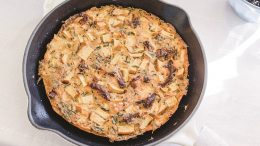As the beautiful Pennsylvania landscape takes on its legendary colors and the unwelcome first frost arrives, home gardeners often have questions about fall tasks.
Here are seven concerns with answers to make your autumn easier and pave the way for an early start on next year’s garden.
Do I have to cut down everything?
Answer: Some plants should be left standing. After the first frost, pull out annuals and plant debris from the kitchen garden. Throw plants on the compost, except for any diseased material which should be bagged and placed in the trash. Don’t cut down perennials that add interest to the winter landscape: I leave ornamental grasses such as feather reed grass (Calamagrostis) with its tall plumes, and perennials such as blue false indigo (Baptisia australis) that has interesting elongated black seedpods. Some plants provide food for birds and you should not cut these down. For example, goldfinches love the seed heads of purple coneflower (Echinacea purpurea). Overwintering birds find protection in plant stubs and ground covers. Many perennials help beneficial insects in winter by providing shelter from their predators. Don’t cut back marginally hardy plants like garden mums (Chrysanthemum spp.) as their tops help them survive the cold of winter. There is no need to cut back low-growing evergreen or semi-evergreen perennials such as hardy geraniums, heucheras, hellebores, and moss phlox. You must cut back plants diseased with powdery mildew such as bee balm (Monarda). Remember to destroy, not compost, diseased stems and leaves.
What is a cover crop?
Answer: A cover crop is a living mulch that protects the soil from erosion, compaction, and weeds. Cover crops retain nutrients in the soil; some provide pest and disease control. Plant a cover crop in the fall on fallow areas such as raised vegetable garden beds. If possible, do this before the end of September, but you can plant winter rye in October. Winter rye, barley, oats, and winter wheat add organic material and improve soil structure. Alfalfa, crimson clover, and hairy vetch are legumes that fix nitrogen in the soil. Before planting your vegetables in spring, cut, mow, or pull your cover crop and fork under the remaining “green manure.”
How do I prevent tender plants from dying in the winter?
Answer: Dig up tender bulbs, such as cannas, caladiums, and dahlias, and store them where they will not freeze. Pack them in boxes of sawdust or peat moss. You may want to save seeds from your favorite non-hybrid plants. Find a place in the garage or basement for shrubs or trees that you are growing in pots, especially Japanese maples (Acer spp.) Sometimes I have plants in their nursery pots, still unplanted, in the fall. For these, I dig holes in the empty vegetable garden and heel them in. Last winter, I lost some roses and other shrubs to the harsh winds. This year, I will protect them with burlap windbreaks or enclosures. You can spray the leaves of broadleaf evergreen shrubs with an anti-desiccant to prevent moisture loss caused by cold weather conditions because when the ground is frozen, the evergreens can’t replace moisture lost through the leaves. Use mulch, such as three to five inches of straw, to insulate plant roots from severe winter temperatures.
Must I rake all the leaves?
Answer: Ecologically speaking you do not need to rake leaves, but a heavy layer can smother your lawn grass and prevent new growth in spring. Compacted leaves can promote snow mold diseases that damage turfgrass. The easiest way to treat leaves on your lawn is to pass over them with a mower a few times to shred them into small pieces. This method will return nitrogen to the soil as the chipped leaves decompose. In the garden, you can leave them where they fall, so they help insulate plant roots. I rake them and run them over with the mower then return the shredded leaves to the flower beds. If you want to remove leaves from your garden, add them to your compost pile rather than bagging them and hauling them away. Composting leaves is a great way to recycle nutrients.
Can I plant anything in the fall?
Answer: Plant bulbs in cool weather before the first hard frost; they need an extended cold period to grow foliage and to bloom. Container-grown plants can be put in the ground from early to mid-fall giving them time to establish a root system before the ground freezes. Add a thick layer of mulch to prevent them from heaving out of the ground when it freezes and thaws. October is the best time to plant garlic. Garlic needs a cold treatment for two months to induce bulbing. Grow garlic in soil with a pH of 6.2 to 7.0. Space the cloves four to six inches apart and three to four inches deep, with the root side down. Mulch heavily with straw.
How do I winterize the pond?
Answer: With correct preparation for the winter months it is possible for aquatic plants and fish to survive in your pond for years. When the water temperature drops below 45oF, shut down the filter, remove the filter media and the main pump to prevent damage from freezing. Follow the manufacturer’s recommendations for draining and storing the pump. Stop fertilizing pond plants and remove any yellow, brown, or decaying foliage. Discard floating plants such as water hyacinth (Eichhornia crassipes) with the trash. Never put discarded water garden plants in our natural waterways. Put hardy plants such as blue flag (Iris versicolor) in the bottom of the pond to a depth of 20 inches or more. Place tropical plants like tropical water lilies (Nymphaea) in a tub of water in the basement or other location where the temperature remains above 50°F. Clean the pond by using a skimmer net to remove debris. Prevent the water from freezing by running an air-bubbler. We add a floating deicer with a thermostat to stop ice from sealing off the pond. Do not allow water levels to drop significantly throughout the winter.
I don’t need to weed in the fall, do I?
Answer: It is important that you do a final weeding in the fall before weeds left in the garden go to seed and produce hundreds of new weeds next year. Fall is also the best time to treat lawn weeds with a broadleaf weed killer.
Enjoy the beautiful fall foliage as you “put your garden to bed.” You can look forward to a rest from gardening tasks this winter knowing that you have made a good start to the next growing season.
This educational blog is a series of informative articles from the Penn State Master Gardeners volunteers plus news concerning the group and their activities. For more information, click here.










































